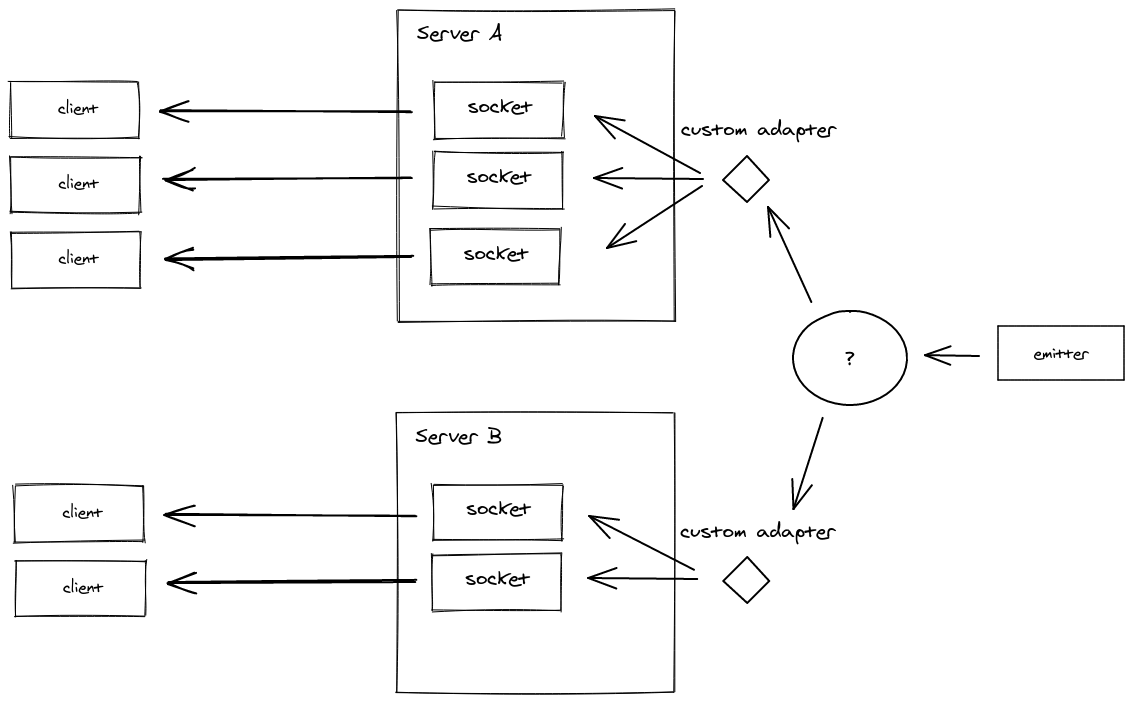Adapter
An Adapter is a server-side component which is responsible for broadcasting events to all or a subset of clients.
When scaling to multiple Socket.IO servers, you will need to replace the default in-memory adapter by another implementation, so the events are properly routed to all clients.
Besides the in-memory adapter, there are four official implementations:
- the Redis adapter
- the MongoDB adapter
- the Postgres adapter
- the Cluster adapter
There are also several other options which are maintained by the (awesome!) community:
Please note that enabling sticky sessions is still needed when using multiple Socket.IO servers and HTTP long-polling. More information here.
API#
You can have access to the adapter instance with:
// main namespaceconst mainAdapter = io.of("/").adapter; // WARNING! io.adapter() will not work// custom namespaceconst adminAdapter = io.of("/admin").adapter;Starting with socket.io@3.1.0, each Adapter instance emits the following events:
create-room(argument: room)delete-room(argument: room)join-room(argument: room, id)leave-room(argument: room, id)
Example:
io.of("/").adapter.on("create-room", (room) => { console.log(`room ${room} was created`);});
io.of("/").adapter.on("join-room", (room, id) => { console.log(`socket ${id} has joined room ${room}`);});Emitter#
Most adapter implementations come with their associated emitter package, which allows communicating to the group of Socket.IO servers from another Node.js process.

This may be useful for example in a microservice setup, where all clients connect to the microservice M1, while the microservice M2 uses the emitter to broadcast packets (uni-directional communication).
Emitter cheatsheet#
// to all clientsemitter.emit(/* ... */);
// to all clients in "room1"emitter.to("room1").emit(/* ... */);
// to all clients in "room1" except those in "room2"emitter.to("room1").except("room2").emit(/* ... */);
const adminEmitter = emitter.of("/admin");
// to all clients in the "admin" namespaceadminEmitter.emit(/* ... */);
// to all clients in the "admin" namespace and in the "room1" roomadminEmitter.to("room1").emit(/* ... */);The emitter also supports the utility methods that were added in socket.io@4.0.0:
socketsJoin()
// make all Socket instances join the "room1" roomemitter.socketsJoin("room1");
// make all Socket instances of the "admin" namespace in the "room1" room join the "room2" roomemitter.of("/admin").in("room1").socketsJoin("room2");socketsLeave()
// make all Socket instances leave the "room1" roomemitter.socketsLeave("room1");
// make all Socket instances in the "room1" room leave the "room2" and "room3" roomsemitter.in("room1").socketsLeave(["room2", "room3"]);
// make all Socket instances in the "room1" room of the "admin" namespace leave the "room2" roomemitter.of("/admin").in("room1").socketsLeave("room2");disconnectSockets()
// make all Socket instances disconnectemitter.disconnectSockets();
// make all Socket instances in the "room1" room disconnect (and discard the low-level connection)emitter.in("room1").disconnectSockets(true);
// make all Socket instances in the "room1" room of the "admin" namespace disconnectemitter.of("/admin").in("room1").disconnectSockets();
// this also works with a single socket IDemitter.of("/admin").in(theSocketId).disconnectSockets();serverSideEmit()
// emit an event to all the Socket.IO servers of the clusteremitter.serverSideEmit("hello", "world");
// Socket.IO server (server-side)io.on("hello", (arg) => { console.log(arg); // prints "world"});